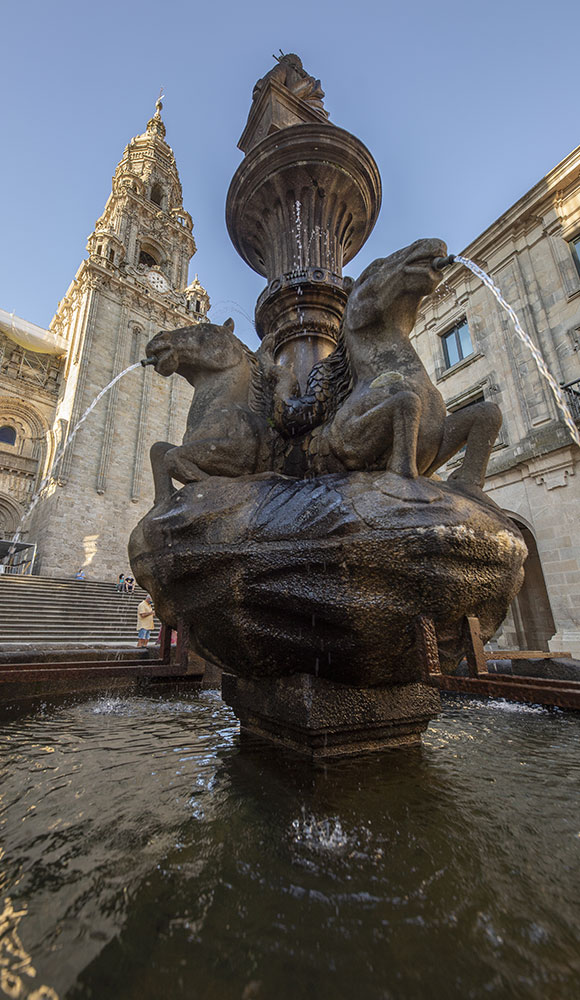Frequently Asked Questions
Solve those little doubts that we all encounter before starting a journey of this kind.
1. What are the main reasons for doing the Camino Inglés?
Whilst devotion and religion are obviously amongst the reasons why pilgrims decide to do the Camino de Santiago, others choose to do it for personal fulfillment, the physical challenge, as a way of disconnecting, discovering new places or meeting people. Each pilgrim experiences a different Camino but all have the same destination.
2. Is it possible to do the Camino alone?
The Camino can be done in a group or individually. Along the Camino, you will meet different pilgrims, each with their own story and personal experience and perception of the Camino. If what worries you is the safety of the Camino or the possibility of any mishap, you can rest assured as the Camino Inglés is a completely safe option. There are many pilgrims who venture along this route alone to Santiago de Compostela. Do not forget that the Camino is characterised by its hospitality and solidarity, so you will always be supported were any problem to arise.
3. Can you do the Camino de Santiago with pets?
The Camino Inglés can be done accompanied by a dog, no problem, although if this is the case you have to take into account their practical needs. Regarding accommodation, it is advisable to ask in advance if pets are allowed and, if so, what the set-up is like for animals. In public hostels, it is generally not possible to sleep with pets, however, there are private hostels that will allow it.
4. What is the difference between the Compostela and the Credencial?
The credential is a document that the pilgrim carries during his Camino and gets stamped to certify the correct completion of the route. Once the Camino has been completed, the Compostela is the document the pilgrim is issued certifying that the requirements have been met and the stages have been done. It could be considered as the final "diploma" for having completed the Camino.
5. How do I get my credential?
The credential is obtained through the Brotherhoods of the Apostle St. James and the authorised associations. In A Coruña it is possible to buy it in the church of Santiago and in Ferrol in the co-cathedral of San Julián (San Xiao).
6. What is the minimum number of kilometres the pilgrim must do to obtain the Compostela?
To get the Compostela, you have to walk at least 100 km or 200 km by bicycle or horseback. In the case of A Coruña, it is possible to get it even if it is a shorter distance, if the pilgrims are residents in this city. To prove this, it will be necessary to show some identification but a proof of address too such as ID, Council Tax, a rental contract or any other official document that proves where you live.
7. Is it necessary to book the hostels, hotels or guesthouses where we are going to sleep?
In the public hostels, bookings are made on a first-come, first-served basis, although in the COVID-19 situation it is possible to book from 1:00pm onwards on the day before through the website alberguesxacobeo.gal . In private hostels, you can of course pre-book a bed if you want the peace of mind that you have a bed for the night guaranteed.
8. Is it possible to stay in a hostel for more than one day?
In general, the maximum stay in a public hostel is one night. However, it is possible to stay an extra day due to illness, injury or other exceptional situations. If in doubt, you can any make enquiries by calling the hostels before starting the route.

9. Is it safe?
The Camino Inglés covers about 200 km with its two variants. Although it is a safe area passing through many populated vicinities along the route, it is always advisable to keep personal belongings in check.
On the other hand, given the current situation of Covid-19, the accommodation, and establishments along the Camino Inglés have taken extreme precautions. Capacities have been reduced, hygiene has increased considerably and in addition, protocols for pilgrims have been implemented on a mandatory basis. Among the protocols are the taking of temperature, the packing of the backpack and footwear on arrival, use of hydrogels, maintaining safety distances to prevent contagion, and any other measures currently required by law.
10. Is it well signposted or do I need a guide or map?
The Camino Inglés is clearly signposted along most of its route, though it never hurts to carry a map or take a guide to know the more hidden peculiarities of the route. A useful option is to download an app on your mobile phone with maps and routes of the Camino de Santiago.
11. How do I find my way along the Camino?
Along the Camino there is clear signage that indicates the direction of the Camino de Santiago. The yellow arrows located on the milestones or in strategic locations make it easy to find your way along the route.
12. On average, how much money am I likely to spend each day?
The price of public hostels is 8 euros per person per night. We estimate a daily budget of between 25 and 30 euros per day, including meals. However, as there are different ways of doing the Camino, depending on the type of accommodation and catering chosen, the cost may vary.
13. Do I have to carry cash?
Although it is possible to pay by credit card in many restaurants and bars along the route, it is advisable to carry cash for the hostels and even for the different shops and stalls you may find along the way.
14. What kind of clothes should I wear on the Camino?
The ideal clothing should be light, comfortable and easy to wash and dry. It is advisable to pack soap to wash your clothes when you arrive at the hostels.
15. What footwear should I wear?
To avoid chafing and blisters, it is highly recommended that you wear well worn-in footwear that fits you perfectly. There are also specific walking socks that can make your journey more comfortable.
16. What objects can make the Camino de Santiago easier for me?
There are a few everyday objects that can make life easier during the Camino. For example, you might consider taking some small kitchen utensils, some sterilised needles in case you get blisters, and a small sewing kit to mend any clothes.
17. Is it possible to wash clothes in the hostels?
In some hostels it is possible to find coin-operated washing machines and dryers. However, others have a laundry room and a clothesline with a rope to hang the clothes once they have been cleaned, so it is advisable to pack some clothes pegs for drying.
18. How much weight should I carry in my backpack?
The recommended weight of your backpack should not exceed 10% of the total weight of the person. Overloading can lead to injuries to the back, joints and other parts of the body.
19. What is the best time to do the Camino?
The Camino Inglés has less rainy weather from the beginning of May until September. However, with its mild coastal climate – discovering the true identity of this Jacobean route can be done at any time of the year.
20. What is the best time to walk?
The early hours of the morning are usually the coolest, so they are ideal for walking. Also, getting up early means you will get to the next hostel earlier, assuring yourself of a bed for the night, having more time to rest and enjoy the surrounding environment...
21. How many kilometres do I walk a day?
How fit each person is will determine the number of kilometres they can walk each day. Our recommendation is that you set a realistic pace that allows you to enjoy the completion of the Camino, while avoiding possible injuries from over-doing it. In addition, this will allow you more time to explore and appreciate the Camino. Our recommendation, depending on the stages’ difficulty, is to average between 16 and 25 km per day.
22. How do I apply for the Compostela at the end of the Camino?
You can apply for it at the Pilgrim Assistance Office, located in rúa das Carretas. Follow the instructions and you will obtain the Compostela if you have met the requirements.


